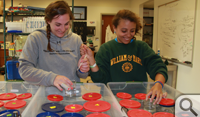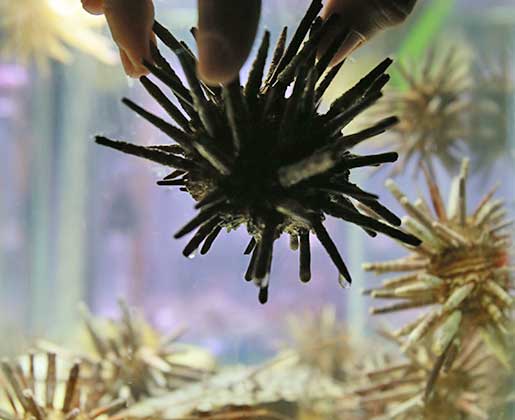Invertebrate love
It’s spring, and that means it’s time to breed the sea urchins
Spring is in full bloom in William & Mary’s biology labs, with more than 350 undergraduate students spawning marine invertebrates.
The new additions to the labs include a variety of worms, sea squirts and snails and an assortment of recently acquired sea urchins.
 Jonathan Allen,
co-director of William & Mary’s marine science minor, said that the
students are using the newly acquired species as an opportunity to study
invertebrate development from reproduction to adulthood. Allen is particularly
excited about the new shipment of sea urchins from all over the east coast,
from Maine to Florida. He explained that marine science students inject the sea
urchins with a salt solution that stimulates muscles in order to cause the sea
urchins to release eggs or sperm.
Jonathan Allen,
co-director of William & Mary’s marine science minor, said that the
students are using the newly acquired species as an opportunity to study
invertebrate development from reproduction to adulthood. Allen is particularly
excited about the new shipment of sea urchins from all over the east coast,
from Maine to Florida. He explained that marine science students inject the sea
urchins with a salt solution that stimulates muscles in order to cause the sea
urchins to release eggs or sperm.
“In the lab we collect the eggs and sperm, fertilize the eggs, and get lots of little babies. From there we grow them into larvae and then juveniles, and all of the way we’re doing experiments on them,” said Allen, assistant professor of biology.
Ecology, evolution and development
Allen explained that there are three areas the students focus on in their experiments—ecology, evolution and development. Ecological inquires include what the organisms eat and what eats them, while evolutionary questions that arise could be aimed at the size of the eggs produced. Allen’s current interest lies with how ecology and evolution interact with a third category, development, especially how environmental changes in salinity or temperature affect the organisms.
“Where those categories overlap is where research questions come about,” Allen said.
Biology students are observing how these spineless creatures develop from reproduction to adulthood. Allen explained that the department’s new sea urchins have given students the perfect opportunity to study the unusual metamorphic process of sea urchins.
Imagine a caterpillar, only with a little butterfly inside
“The juvenile sea urchins develop from a rudiment inside of the larvae,” explained Allen, “Larvae go through metamorphosis the way a caterpillar turns into a butterfly, but it would be like if the caterpillar had a little butterfly inside of it. Rather than build a cocoon, the larval body functions as a sort of living cocoon for the juvenile to emerge from.”
Students studying marine science also have the opportunity to observe worms that live in tubes, filtering water through them and collecting food in mucus bags along their bodies. While cutting these worms out of their tubes to observe them, students also look to the edges of these tubes where sea snails have laid their spiny egg capsules. The next tank over holds another interesting marine organism, sea squirts. These snails squirt filter water through one opening and squirt it out through the other.
Everybody loves the baby lobster
Perhaps the organism greeted with the most enthusiasm in the department is the baby lobster, burrowing holes in the tank it shares with an adult lobster. Allen explained that this lobster is used in the summer as a predator in experiments with sea urchins.
Allen is enthusiastic about the recent additions to the labs and the hands-on access the reproducing organisms have allowed for students.
“You take
science and you get students exposed to it and you get what you’re doing in the
lab to feed into what you’re doing in the classroom,” said Allen. “Hundreds of
students are getting exposed to something real.” ![]()















